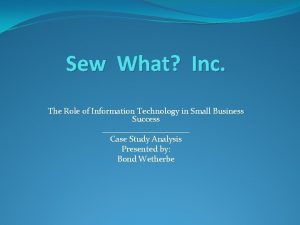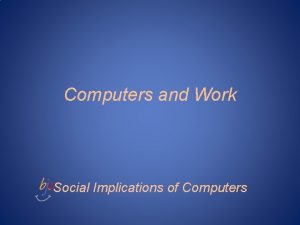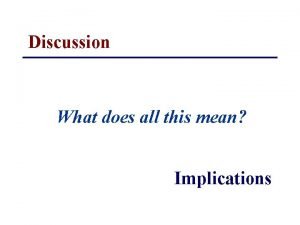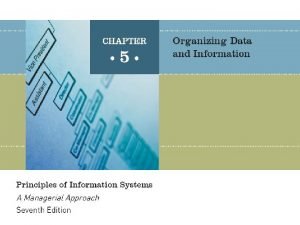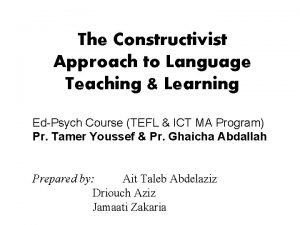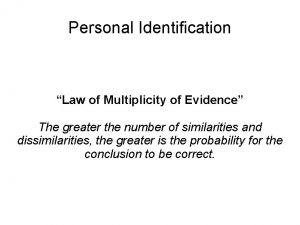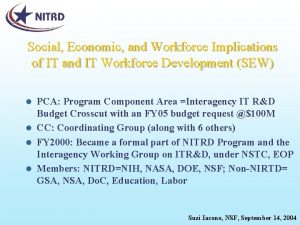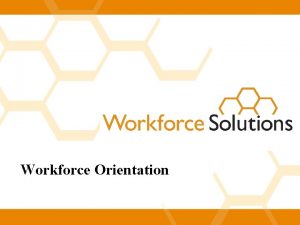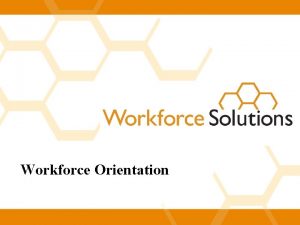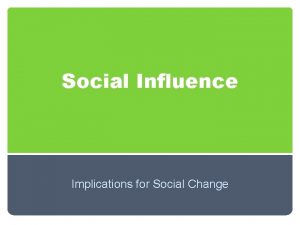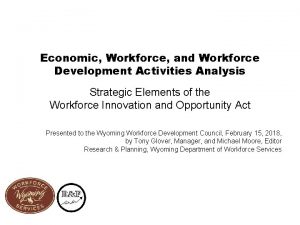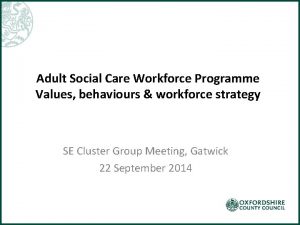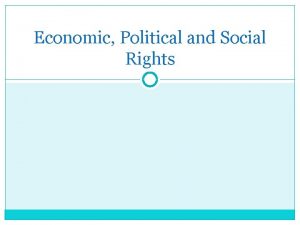Social Economic and Workforce SEW Implications of IT



















- Slides: 19

Social, Economic and Workforce (SEW) Implications of IT: IT R & D Digital Government Consortium Meeting March 15, 2001 Dr. Suzi Iacono, siacono@nsf. gov SEW co-chair, Computation and Social Systems PD http: //www. interact. nsf. gov/cise/descriptions. nsf/PD/css

Agenda l l l SEW Interagency PCA SEW Objectives SEW Challenges? What are we proposing to do? Conclusions

SEW Interagency PCA l l l l SEW: Social, Economic and Workforce Implications of IT and IT Workforce Development PCA: Program Component Area =Budget Crosscut FY 2000: Became a formal part of Federal IT R&D Members: Formal=NIH, NASA, DOE, NSF, Informal= GSA, NSA, and Education Formal Three Foci: • Social and Economic Implications of IT Research • IT Workforce and Educational Technology Research • IT Workforce Development SEW Budget Requests: FY 00: $41 M; FY 01: $65 M Meeting: 4 th Wednesday, 10: 30 AM

SEW Objectives 1. To attain positive benefits from the increasing use of IT in all sectors of society and to overcome barriers and problems, increased funding is needed to extend the existing SEW research programs through increased funding and new areas of emphasis. 2. To grow and sustain the community of researchers working in this area and to inform national policy, build a national SEW infrastructure. 3. To legitimize and make visible the contributions of this research area, SEW research centers should be funded through the ITR initiative. 4. To train and retrain scientists and researchers for the IT workforce, innovative educational development programs (e. g. , graduate fellowships) should be funded.

SEW Successes · The “productivity paradox” – the time lag between IT investment and advances in worker productivity · Network externalities – the research finding that products, such as Internet connectivity, of IT businesses often increase in value as more people use them. This insight led to the emphasis on getting products and services to market quickly and pricing them low to spur market growth. · Distribution of IT benefits – research showing that peripheral members of social systems benefit more from IT use than do central members influenced policy decisions about subsidies for and access to the Internet.

SEW Challenges l Highly multi-disciplinary research area • fragmented across academia • lacks a stable identity, label or home • each discipline conceptualizes the problem differently

Current Research on Social and Economic Implications of IT: Causal Perspectives Design & Development of IT Use of IT Social, Behavioral, Economic, Legal and Ethical Outcomes of IT

Current Research on Social and Economic Implications of IT: Disciplinary Focus Social, Behavioral, Design & Development of IT Computer and Information Sciences Focus on the Artifact (and Use) Use of IT Economic, Legal and Ethical Outcomes of IT Social and Economic Sciences Focus on the Social Outcomes (and Use) Minimal Overlap at Use

Current Research on Social and Economic Implications of IT: Disciplinary Focus Design & Development of IT Use of IT Computer and Information Sciences Focus on the Artifact (and Use) Minimal Overlap at Use Social, Behavioral, Economic, Legal and Ethical Outcomes Social and Economic Sciences Focus on the Social Outcomes (and Use)

Current Research on Social and Economic Implications of IT: Disciplinary Focus Design & Development of IT Use of IT Computer and Information Sciences Focus on the Artifact (and Use) Minimal Overlap at Use Social, Behavioral, Economic, Legal and Ethical Outcomes Social and Economic Sciences Focus on the Social Outcomes (and Use)

Reconceptualization of Research on Social and Economic Implications of IT: Interdisciplinary Focus Design & Development of IT New designs Use of IT Social, Behavioral, Economic, Legal and Ethical Outcomes Unanticipated Uses Increase the overlap to include the artifact and social outcomes/context Unanticipated Outcomes

SEW Challenges (2) l l Research and policy/program dimensions are separate IT Funding has been focused on developing the artifacts rather than on how they come to be the way they are, why they get used (or not), how they are embedded into social contexts or what their longer-term implications might be yet • positive benefits are not automatic • IT can have unintended consequences and unintended uses Only a few of the 4000+ institutions of higher learning in the US have courses in this area or critical mass of faculty doing research This research area has been underfunded yet • proposals in this area are growing each year • 100% more SEW proposals in ITR had excellent evaluations than were funded

What are we proposing to do? l Extend Existing Research Programs and Areas of Emphasis to include: • Universal Participation in a Digital Society (digital divide, use by the disabled, global digital economy, changes in worklife, internet and society, good cybercitizens, cybercrime, informed participation, internet governance, telemedicine for everyone) • Information Privacy and Intellectual Property in a Digital Society • Large-scale Social Technologies for Work Collaboration and Learning (CSCW, CSCL, coordination and interaction in heterogeneous systems, self-organizing systems, , motivations and challenges related to adoption and use) • Ethical Principles and Socio-technical Design • Technologies for Successful Aging • IT Workforce • IT in Education Research

Areas of Research Emphasis l Understanding what it means to live, work, learn, do business, and be a citizen in a digital society • • • ITR: The Educational Consequences of the Digital Divide: Paul Attewell, CUNY Graduate School ITR: Home. Net. Too: Motivational, affective and cognitive factors and Internet use: Explaining the digital divide and the Internet paradox: Linda Jackson, Michigan State University ITR: Globalization, Electronic Commerce and Social Impacts: The Influence of National Environments on Diffusion and Impacts of the Internet: Kenneth Kraemer, University of California-Irvine ITR: Social and Economic Implications of Information Technology: What Is Really Happening? : Wanda Orlikowski, MIT ITR: Interdisciplinary Views of the Blacksburg Electronic Village: John Carroll, Virginia Polytechnic Institute CSS: Telephones, TV and the Internet: The Impact Information Technology in the Home Has on Social Involvement and Psychological Well-Being, Robert Kraut, CMU

Areas of Research Emphasis l Improving our understanding of how we as a society view information privacy and IP rights and infringements • A report by the Committee on Intellectual Property Rights and the Emerging Information Infrastructure at the National Academy of Sciences focuses on issues related to Intellectual Property in the Information Age. • SDEST: Controlling the Technologies of Privacy Invasion, Rule, SUNY Stonybrook l Collaborating across distances and with various intelligent applications and devices in the course of working, learning, and conducting business • ITR: Sustainable and Generalizable Technologies to Support Collaboration in Science: Gary Olson, University of Michigan Ann Arbor • ITR: Groupware-Mediated Cooperative Programming: Teaching Technology to Non-Scientists: Timothy Hickey, Brandeis University

Areas of Research Emphasis l Developing and Using ethical principles and human values during IT design • CSS: Values and Protocol Design, Jean Camp, Harvard U. • ITR: Understanding Open Software Communities, Processes and Practices: A Socio-Technical Approach: Mark Ackerman, University of California Irvine • ITR: Understanding "Code": How Information Technologies Regulate Behavior: Jay Kesan, University of Illinois, Urbana. Champaign • CSS: Informed Consent Online, Batya Friedman, U WA and Ed Felton, Princeton U. • CSS: Software Development Impact Statements: Identifying and Responding to the Ethical Dimensions of Software Projects

Areas of Research Emphasis l l Information Technology Workforce • ITR: Women-friendly Environments for Learning Information Technology: Deborah Walters, SUNY Buffalo • ITR: Research, Curriculum and Partnerships for Broadening the Information Technology Pipeline, Robert Schnabel, University of Colorado Boulder Information Technology in Education • ITR: A Distributed Simulation Infrastructure for a K-12 Inquiry Environment: Thomas Gottschalk, California Institute of Technology • ITR: Systems for Learning Science and Assessing Student Learning: Brian Slator, North Dakota State University, Fargo

What are we proposing to do? (2) l Build a National SEW Infrastructure • Scholarships for students to attend schools with SEW programs • Mentoring programs for underrepresented faculty and graduate students • National clearing house for the SEW research area • National SEW conferences

Conclusions l l l SEW operates at a low level relative to other IT R&D research areas SEW must be expanded quickly to address the various national challenges that have been articulated Ramp up will build an adequate IT workforce and develop educational technologies for K-12 and for lifelong learning
 Present continuous questions
Present continuous questions Sew vs sue
Sew vs sue Drink simple past
Drink simple past Sew what inc
Sew what inc Push back bob sew in
Push back bob sew in Legal implications of social media
Legal implications of social media Social implications of computers
Social implications of computers Prof. meier and baldwin
Prof. meier and baldwin Discussion and implications
Discussion and implications Economic growth vs economic development
Economic growth vs economic development Economic systems lesson 2 our economic choices
Economic systems lesson 2 our economic choices Social thinking and social influence
Social thinking and social influence Social thinking social influence social relations
Social thinking social influence social relations Implications of database approach
Implications of database approach Educational implications of constructivism
Educational implications of constructivism Implication chart method
Implication chart method Nursing implications for synthroid
Nursing implications for synthroid Herman welcker
Herman welcker Eng2d media unit
Eng2d media unit Marketing implications
Marketing implications



